Nature Connection in Australia
Why explore nature connection?
Studies around the world have shown that people who are more connected with nature are more likely to engage in pro-environmental behaviours, highlighting its importance as a leverage point for sustainability. This is why it features prominently in a number of conservation policies, including Australia’s Strategy for Nature. Nature connection has multiple dimensions – in our study, we measure it through the three dimensions of identity, experience and philosophy. While the health and wellbeing benefits of physical activity in nature are well documented, connecting with nature cognitively and emotionally, such as by observing nature through a window or in a nature can have significant benefits for physical health, wellbeing and pro-environmental behaviours.
For these reasons, enhancing nature connection is crucial for improving both the wellbeing of people and planet.
About the Nature Connection Project
While nature connection has been explored internationally, we know little about how nature connection – and its relationship with wellbeing and pro-environmental behaviours - varies across Australian geographies and demographics. The nature connection project fills this gap by exploring the diverse ways Australians connect with nature and how this relates to their wellbeing and pro-environmental behaviours.
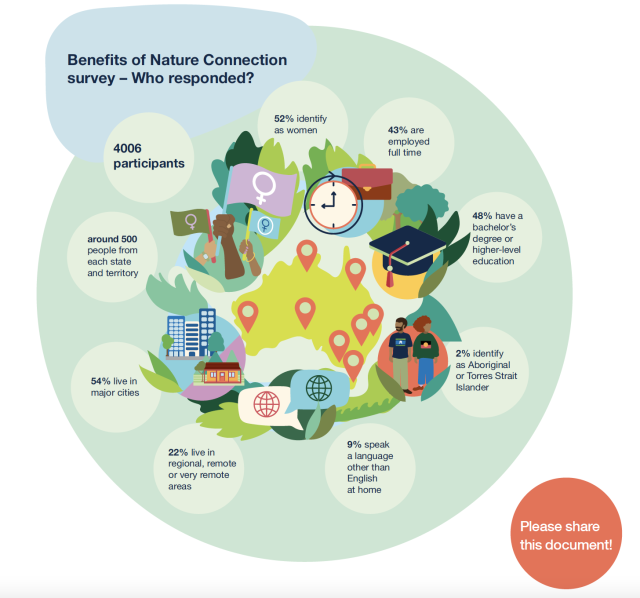
These groups span characteristics such as age, gender, Indigenous status, educational background, employment, income, linguistic diversity, and geography. Where an individual grew up was particularly important in predicting nature connectedness later in life, with people from rural and regional Australia being more connected with nature.
There were interesting differences between nature connection and nature contact, as well as between different nature connection measures. This highlights the importance of carefully considering the tools used to measure nature connection and nature contact.

The three dimensions of identity, experience, and philosophy were examined to understand how nature connection is experienced in Australia. Overall, individuals in Australia are more philosophically connected to nature compared with identity and experiential connections.

The majority of respondents (74%) said they would like to spend more time in nature. The main reason people couldn’t be out in nature as much as they would like was due to not having enough time (72% of respondents).
Other barriers to being in nature included a lack of access (16%), preventative health issues (12%), not knowing where to go (12%) and cost factors (12%). There were other precluding factors also mentioned, including weather, ageing, pet restrictions, caring duties, transport and a desire to avoid impacting on the environment.
In our research, health inequities paralleled nature access inequities; that is, people experiencing social and environmental barriers to good health also experience the double bind of barriers to nature connection.
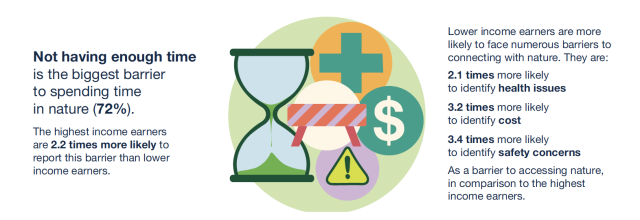
Governments across Australia can do more to enhance nature connectedness.
Given that around 85% of Australians live in cities, which are becoming more populated and compact, we need to ensure all people in Australia have access to green space and are meaningfully connecting with these spaces in sustainable ways.
Context is also important; different population groups (ages, cultures, physical abilities) have different needs and ways of engaging with nature. Across an urban landscape, green spaces need to accommodate diverse uses and adjust as communities change.
Reducing structural inequalities is key to ensuring equality of access to nature.
Our results show that cost, health issues, and safety concerns are key barriers affecting engagement with nature. These barriers are more likely to impact people on lower incomes. Universal access, for example age- and dementia-friendly environmental design, is important to ensure everyone in Australia can gain wellbeing benefits from our natural areas. The implications for urban planning policies are clear: free, open, inclusive, and activated green spaces within walking distance of everyone’s home would be an invaluable strategy for enhancing nature connectedness.
For many individuals, not having enough time is a key barrier to engaging with nature.
This indicates the need for societal shifts to prioritise taking time out in nature. This could include workplaces reducing work hours to enable individuals to spend more time in nature. Furthermore, public health campaigns can help support people to integrate moments in nature in our day-to-day lives through activities such as eating lunch in a park, spending work breaks outside, and walking or cycling to work if possible.
Enriching our lives.
Finally, enhancing the pathways to nature connectedness through sensory, contact, emotion meaning, beauty, and compassion paradigms will help support nature connectedness at a societal level. For example, interventions such as cultural programs and urban design can help facilitate more meaningful engagement with nature.
Being connected with nature can enrich our lives, and help support people to value and care for our natural environments. As we face global environmental, wellbeing and sustainability challenges, enhancing nature connectedness can bring positive changes for both people and planet.
Full Research Paper:
Being connected with nature can enrich our lives, and help support people to value and care for our natural environments. As we face global environmental, wellbeing and sustainability challenges, enhancing nature connectedness can bring positive changes for both people and planet.
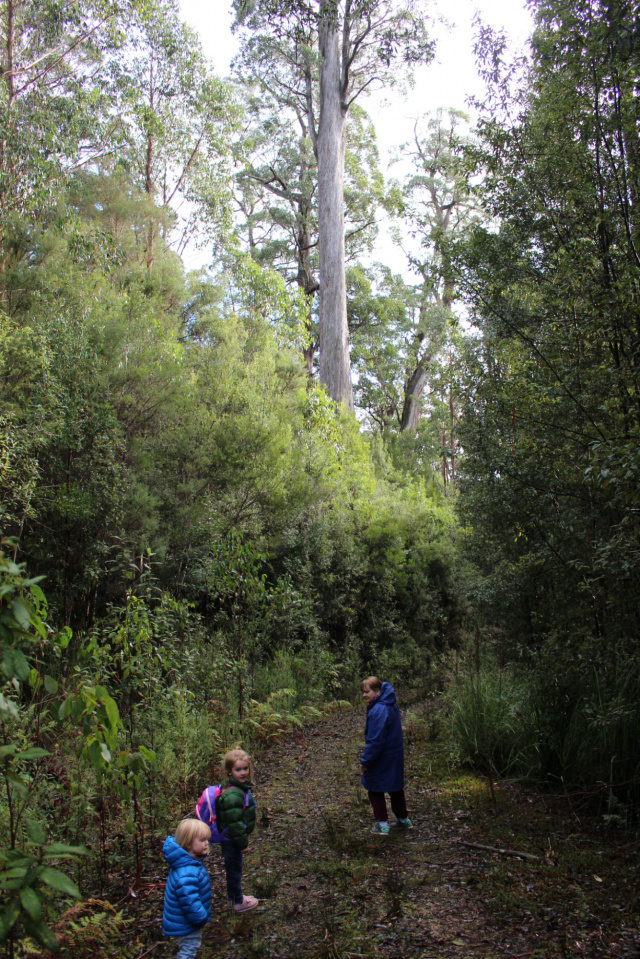
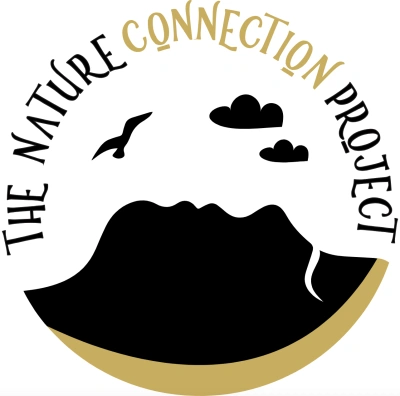
The Nature Connection Project
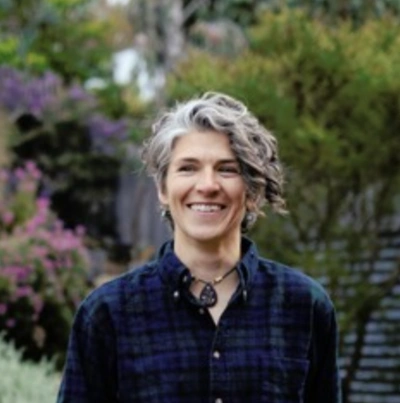
Emily Flies
Senior lecturer in environments and sustainable communities
Why explore nature connection?
Studies around the world have shown that people who are more connected with nature are more likely to engage in pro-environmental behaviours, highlighting its importance as a leverage point for sustainability. This is why it features prominently in a number of conservation policies, including Australia’s Strategy for Nature. Nature connection has multiple dimensions – in our study, we measure it through the three dimensions of identity, experience and philosophy. While the health and wellbeing benefits of physical activity in nature are well documented, connecting with nature cognitively and emotionally, such as by observing nature through a window or in a nature can have significant benefits for physical health, wellbeing and pro-environmental behaviours.
For these reasons, enhancing nature connection is crucial for improving both the wellbeing of people and planet.
About the Nature Connection Project
While nature connection has been explored internationally, we know little about how nature connection – and its relationship with wellbeing and pro-environmental behaviours - varies across Australian geographies and demographics. The nature connection project fills this gap by exploring the diverse ways Australians connect with nature and how this relates to their wellbeing and pro-environmental behaviours.

These groups span characteristics such as age, gender, Indigenous status, educational background, employment, income, linguistic diversity, and geography. Where an individual grew up was particularly important in predicting nature connectedness later in life, with people from rural and regional Australia being more connected with nature.
There were interesting differences between nature connection and nature contact, as well as between different nature connection measures. This highlights the importance of carefully considering the tools used to measure nature connection and nature contact.

The three dimensions of identity, experience, and philosophy were examined to understand how nature connection is experienced in Australia. Overall, individuals in Australia are more philosophically connected to nature compared with identity and experiential connections.

The majority of respondents (74%) said they would like to spend more time in nature. The main reason people couldn’t be out in nature as much as they would like was due to not having enough time (72% of respondents).
Other barriers to being in nature included a lack of access (16%), preventative health issues (12%), not knowing where to go (12%) and cost factors (12%). There were other precluding factors also mentioned, including weather, ageing, pet restrictions, caring duties, transport and a desire to avoid impacting on the environment.
In our research, health inequities paralleled nature access inequities; that is, people experiencing social and environmental barriers to good health also experience the double bind of barriers to nature connection.

Governments across Australia can do more to enhance nature connectedness.
Given that around 85% of Australians live in cities, which are becoming more populated and compact, we need to ensure all people in Australia have access to green space and are meaningfully connecting with these spaces in sustainable ways.
Context is also important; different population groups (ages, cultures, physical abilities) have different needs and ways of engaging with nature. Across an urban landscape, green spaces need to accommodate diverse uses and adjust as communities change.
Reducing structural inequalities is key to ensuring equality of access to nature.
Our results show that cost, health issues, and safety concerns are key barriers affecting engagement with nature. These barriers are more likely to impact people on lower incomes. Universal access, for example age- and dementia-friendly environmental design, is important to ensure everyone in Australia can gain wellbeing benefits from our natural areas. The implications for urban planning policies are clear: free, open, inclusive, and activated green spaces within walking distance of everyone’s home would be an invaluable strategy for enhancing nature connectedness.
For many individuals, not having enough time is a key barrier to engaging with nature.
This indicates the need for societal shifts to prioritise taking time out in nature. This could include workplaces reducing work hours to enable individuals to spend more time in nature. Furthermore, public health campaigns can help support people to integrate moments in nature in our day-to-day lives through activities such as eating lunch in a park, spending work breaks outside, and walking or cycling to work if possible.
Enriching our lives.
Finally, enhancing the pathways to nature connectedness through sensory, contact, emotion meaning, beauty, and compassion paradigms will help support nature connectedness at a societal level. For example, interventions such as cultural programs and urban design can help facilitate more meaningful engagement with nature.
Being connected with nature can enrich our lives, and help support people to value and care for our natural environments. As we face global environmental, wellbeing and sustainability challenges, enhancing nature connectedness can bring positive changes for both people and planet.
Full Research Paper:
Being connected with nature can enrich our lives, and help support people to value and care for our natural environments. As we face global environmental, wellbeing and sustainability challenges, enhancing nature connectedness can bring positive changes for both people and planet.

Love what you're reading? Support The Nature Connection Project donate to support them now
Donate hereYou might like...

Connection

Connection with nature turns hope into action

Nature's Protection: Heart connection is the key

Children in Nature
Newsletter
Sign up to keep in touch with articles, updates, events or news from Kuno, your platform for nature
